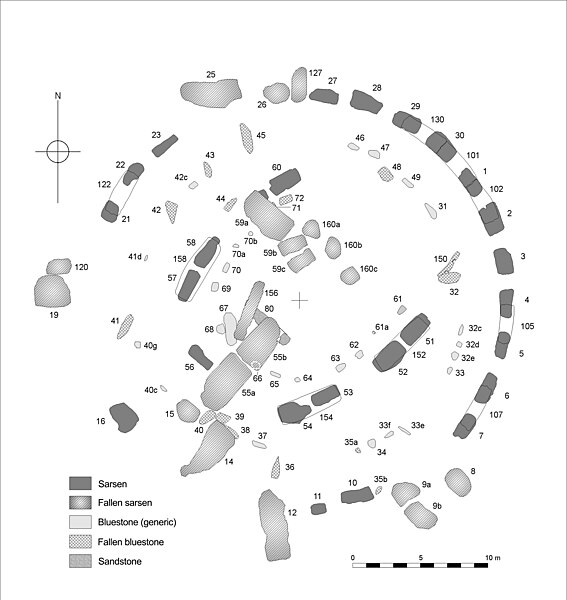
Caption: A little on the geology and structure of Stonehenge: "Map of the central stone structure at Stonehenge as it survives today. Stone numbers are those conventionally used in the recent literature and following Flinders Petrie (1853--1942) in 1880.
Note that the term "Sarsen" used on the key refers to the hard silicified tertiary rock local to the chalkland of the Stonehenge region (i.e., Salisbury Plain). Sarsen is an exceptionally obdurate form of sandstone. The reference to sandstone on the key is to other non-sarsen material. The term bluestone conveniently, though somewhat controversially, describes a generic group of igneous rock exotic to Salisbury Plain. The major group of bluestones visible today are dolerite whose provenance is thought to be southwest Wales. A number of other igneous rocks are represented within the arrays." (Slightly edited.)
A little on the history of Stonehenge:
- The complete Stonehenge
was built and used over a period from
about 3100 BCE
to about 1600 BCE
(see
Wikipedia: Stonehenge: Early history)
with
the main construction of the big features
(i.e., inner ring and the trilithons)
sometime in the period
2600 BCE
to 2400 BCE
(see Wikipedia: Stonehenge:
Stonehenge 3 II (2600--2400 BC)).
- The constructors were
Neolithic Britons
and Bronze Age Britons,
NEITHER of whom were Celts.
It is NOT clear when and how rapidly the Insular Celts arrived or arose from cultural transmission from mainland Europe in the Hiberno-British Isles. Probably after 1000 BCE. See Wikipedia: Insular Celts: Celtic settlement of Britain and Ireland for an inconclusive discussion.
It is the Insular Celts and at least some of rest of the Celts who had Druids---who did NOT build Stonehenge---and did NOT insofar has we know carry demonic rites there---despite what is suggested in Night of the Demon (1957 film).
- In many ways, we know little about the
Neolithic Britons
and Bronze Age Britons.
We do NOT know their language and there is NO textual history.
All we have is the archaeological record.
- Stonehenge acquired its modern
name in
Anglo-Saxon England and probably
means stones hanging in
air, but the possibility
exists that it means stones for hanging:
i.e., gallows
(see Wikipedia: Stonehenge: Etymology).
- Since circa 2000,
we know a lot more from archaeology
about Stonehenge than we ever imaged
we could before.
All the tools of modern
archaeology
have been thrown at it principally by
the Stonehenge Riverside Project
(fieldwork 2003--2009).
One of the directors of the project is
Mike Parker Pearson (1957--).
-
If you arn't mad when you start working on
Stonehenge, you soon will be.
-
---an approximate quotation
from Mike Parker Pearson (1957--),
approximately quoting someone else,
2016
May01 less a few days,
public talk at UNLV.
- In 2020, the origin was identified
for most of the
largest megaliths
of Stonehenge,
the Sarsen stones,
which form the inner ring of
standing stones
with lintels
and the
horseshoe pattern of
5 huge
trilithons within that ring
(see Wikipedia:
Stonehenge: Stonehenge 3 II (2600--2400 BCE)).
They came from West Woods,
now a small forest
near Marlborough, Wiltshire,
25 km
north
of Stonehenge
(see Wikipedia:
Stonehenge: Origin of sarsens identified).
You may well wonder how the Stonehengers transported the Sarsen stones. Modern experiments suggest that they slid the Sarsen stones on logs parallel to the direction of motion perhaps using animal fats (Wikipedia: Lubricant: History) as a lubricant. The Sarsen stones CANNOT have been rolled on logs: the logs just lock on each other. It probably took the Stonehengers a long time to move the Sarsen stones. They probably spent decades building the inner ring and the trilithons.
Credit/Permission: ©
Anthony Johnson,
2008
(uploaded to
Wikimedia Commons
by User:Sitehut,
2008) /
CC BY-SA 3.0.
Image link: Wikimedia Commons:
File:Stone Plan.jpg.
Local file: local link:
stonehenge_map_modern.html.
File: Stonehenge file:
stonehenge_map_modern.html.